Crunchy, spicy, and deeply savory, kkakdugi is a highly popular Korean radish kimchi. And easy to make!
Kkakdugi (깍두기) is a kimchi made with Korean radish, mu (or moo, 무). It’s an easy kimchi to make! Simply cut the radishes into cubes, salt for a short time, and then mix with the seasonings. The name kkakdugi comes from how the radish is cut — cubed, and it’s known as cubed radish kimchi in English.
Korean radish, mu (무), is a variety of white radish and has firm, crisp flesh and a slightly sweet and peppery taste. It’s a cool weather vegetable, so it tastes best in fall and winter. Summer radish can be quite bitter. You can add more sugar than what the recipe calls for to balance out the bitterness.
How to make cubed radish kimchi
Ingredients
- 5.5 pounds (2.5 kg) Korean radishes, mu (무)
- 3 tablespoons Korean coarse sea salt (less if using finer salt)
- 3 – 4 scallions
- 1/2 cup gochugaru (고추가루)
- 3 tablespoons saeujeot (새우젓), salted shrimp – use more fish sauce or salt if unavailable
- 2 tablespoons myulchiaekjeot (멸치액젓), fish sauce
- 8-9 plump garlic cloves (3 tablespoons minced)
- 1 inch ginger (1 teaspoon grated)
- 1/2 Korean pear or apple – optional
- 2 tablespoons cooked rice (heated) – optional
- salt and/or sugar as needed
If using the optional fruit and/or rice, you can blend them together with garlic and ginger.
Cutting the radish
Cut the radish into 3/4 to 1-inch thick discs first. Then cut each disc into the same thickness, 3 or 4 equal sticks, depending on the diameter. Turn the whole thing 90 degrees and then cut again into 3/4 to 1-inch cubes.
Salting
Radishes are 90 some % water, and salting draws out some of their water content for a crunchy texture of kimchi.
Koreans use coarse sea salt for kimchi, but if not available to you, use what you have. You will need to use less if using finer salt. This recipe uses 3 TBS of Korean coarse sea salt, which, for example, is approximately equivalent to 2.5 TBS of coarse Kosher salt or 2 tablespoons of Morton’s canning and pickling salt, which is very fine grain salt.
Sprinkle the salt over the radishes and toss well to distribute the salt. The moisture from the radish dissolves the salt quickly. Let it sit for about an hour, tossing them to rotate once or twice every 20 minutes or so. More salt or longer salting will draw out more water.
Draining
Drain the radishes. The radishes should have released quite a bit of water. Do NOT rinse the radishes and wash off the salt on the surfaces. Discard the drained water! It’s too salty to use, because we are using other salty ingredients.
However, if you’re not using salted shrimp and/or fish sauce, reserve this water and use some of it to season the kimchi.
Mix with Seasonings
The taste of kimchi depends a lot on the types, the quality, and the ratio of the seasoning ingredients. Each Korean household has its own ways. I find myself making it differently each time.
Traditionally, various jeotgal (젓갈, salted seafood) are used in kimchi for the depth of flavors. Saeujeot (새우젓, salted shrimp) and myulchiaekjeot (멸치액젓, fish sauce made with anchovies) are the two that are most commonly used. I almost always use both in my kimchi. For vegan kimchi, use salt to season or use Korean soup soy sauce (gukganjang, 국간장) in combination with salt.
Add the gochugaru, and mix well to coat the radish cubes and rub with your hand. This gives the radish kimchi a nice red color. Then, add the remaining ingredients and mix really well before tossing in the scallions.
Storing and fermenting
Radish kimchi takes longer to ferment than napa cabbage kimchi. Leave the kkakdugi at room temperature for 2 to 3 days during cold months, depending on your actual room temperature and how soon you want to start eating your kimchi. Then keep it in the fridge. It will continue to ferment.
You can enjoy kkakdugi with any Korean meal, but it’s especially good with a bowl of mild soup such as seolleongtang, samgyetang, galbitang, and dak gomtang. It’s a delicious side dish that will add a robust, spicy kick and some crunch to a meal!
Watch how to make it
More kimchi recipes
For more Korean cooking inspirations, follow along on YouTube, Pinterest, Twitter, Facebook, and Instagram.
Kkakdugi (Cubed Radish Kimchi)
Side Dish
Prep Time: 30 minutes
Cook Time: 10 minutes
1 hour
Servings: 48
Ingredients
- ▢ 5.5 Korean radishes (mu, 무) see note 1
- ▢ 3 tablespoons coarse sea salt less if using finer salt
- ▢ 3 or 4 scallions cut into about 1-inch lengths
Seasonings
- ▢ 1/2 cup gochugaru (고추가루) use more or less to taste (a tablespoon or 2)
- ▢ 3 tablespoons saeujeot (새우젓), salted and fermented shrimp see note 2
- ▢ 2 tablespoons myulchiaekjeot (멸치액젓), fish sauce
- ▢ 3 tablespoons minced garlic, 8-9 plump cloves see note 3
- ▢ 1 teaspoon grated ginger, about 1-inch thumb size see note 3
- ▢ 1 tablespoon sugar (adjust to taste or omit) You may need more if your radish is bitter.
- ▢ 1/2 Korean/Asian pear or apple - optional see note 3
- ▢ 2 tablespoon cooked rice, heated if hardened - optional see note 3
Kitchen Tools
- ▢ a large bowl 7 – 8 qt
- ▢ a large colander
- ▢ kitchen gloves
- ▢ 1 gallon or little smaller airtight container or jar
Instructions
Clean the radishes by scrubbing with a brush and/or scratching off the stubborn impurities with a small knife. Peel the skin only if necessary. Cut into 1-inch thick discs, and then cut each disc into 1-inch cubes, placing in a large bowl. (The cubes will look big but will shrink during the salting and fermentation processes.)
Sprinkle the salt over the radishes and toss well to coat evenly. Let sit for about an hour, rotating them halfway through, until the radish surfaces have slightly softened and released some liquid.
Drain the radishes in a colander and discard the liquid. Do NOT rinse. (The radishes still contain sufficient water content that will be released during the fermentation process. With this method, the resulting kkakdugi will have a nice thick juice.)
Place the radishes back in the bowl. Add gochugaru and mix well rubbing the radishes by hand (wear kitchen gloves). Add the remaining seasoning ingredients and mix well to evenly distribute the seasonings. Taste a little bit of the seasoning. It should be a little too salty to eat as is. Add more salted shrimp, fish sauce, or salt if necessary. Toss the scallions in gently. (The radishes will be a little dry at this point, but they will release water during the fermentation process.)
Store in an airtight container or jar. Before closing the lid, press the kkakdugi down hard with your hand to remove air pockets between the radish cubes.
Leave it out at room temperature for two to three days, depending on your room temperature and how fast you want your kimchi to ripe. Then, store in the fridge. Kkakdugi tastes best after a week or two in the fridge to fully develop the flavors. It maintains great flavor and texture for several weeks.
Notes
1. Buy the ones with smooth skins that are firm and heavy.
2. If salted shrimp is not available, increase the fish sauce or salt to season.
3. If using optional fruit and/or cooked rice, blend them with garlic and ginger.

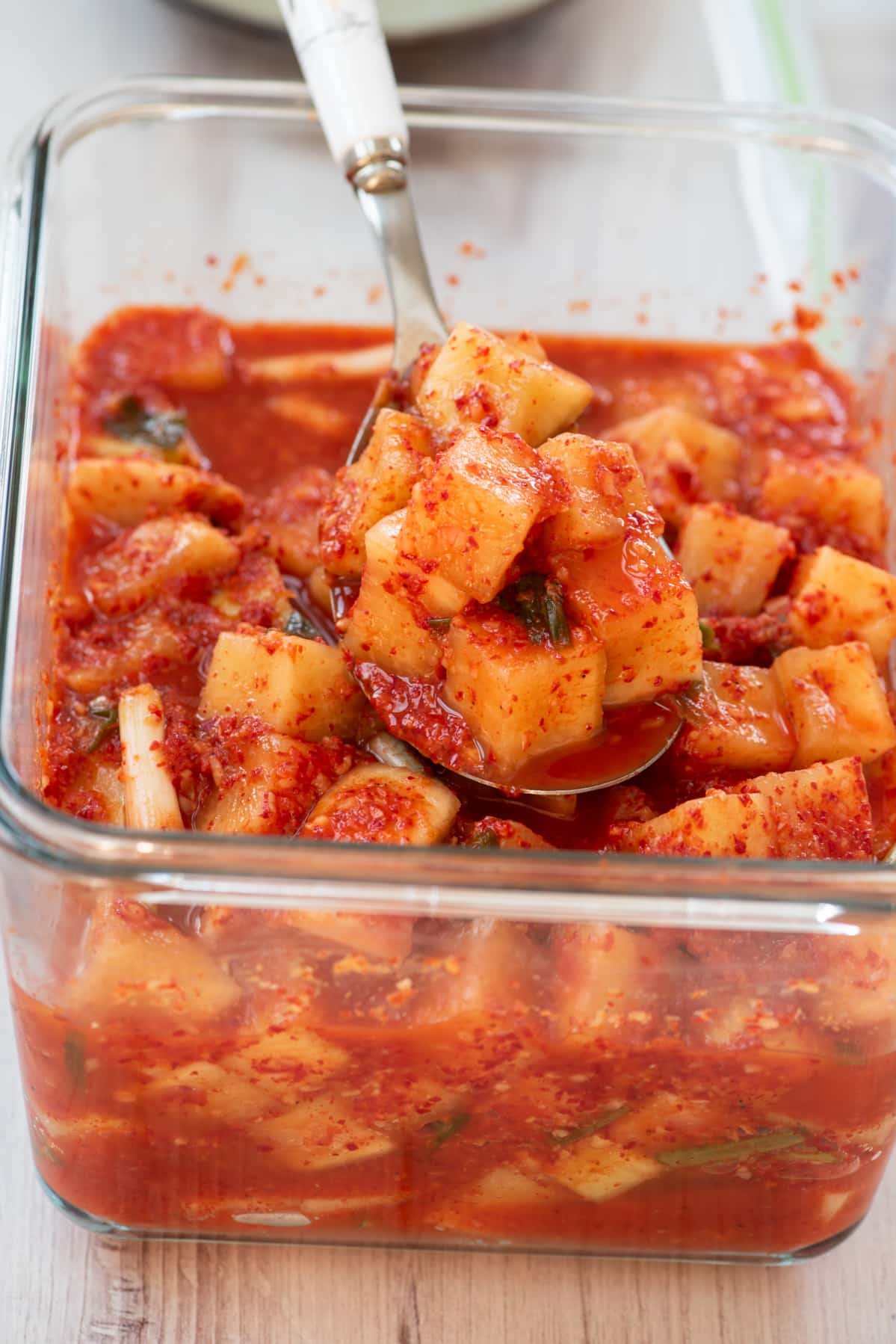
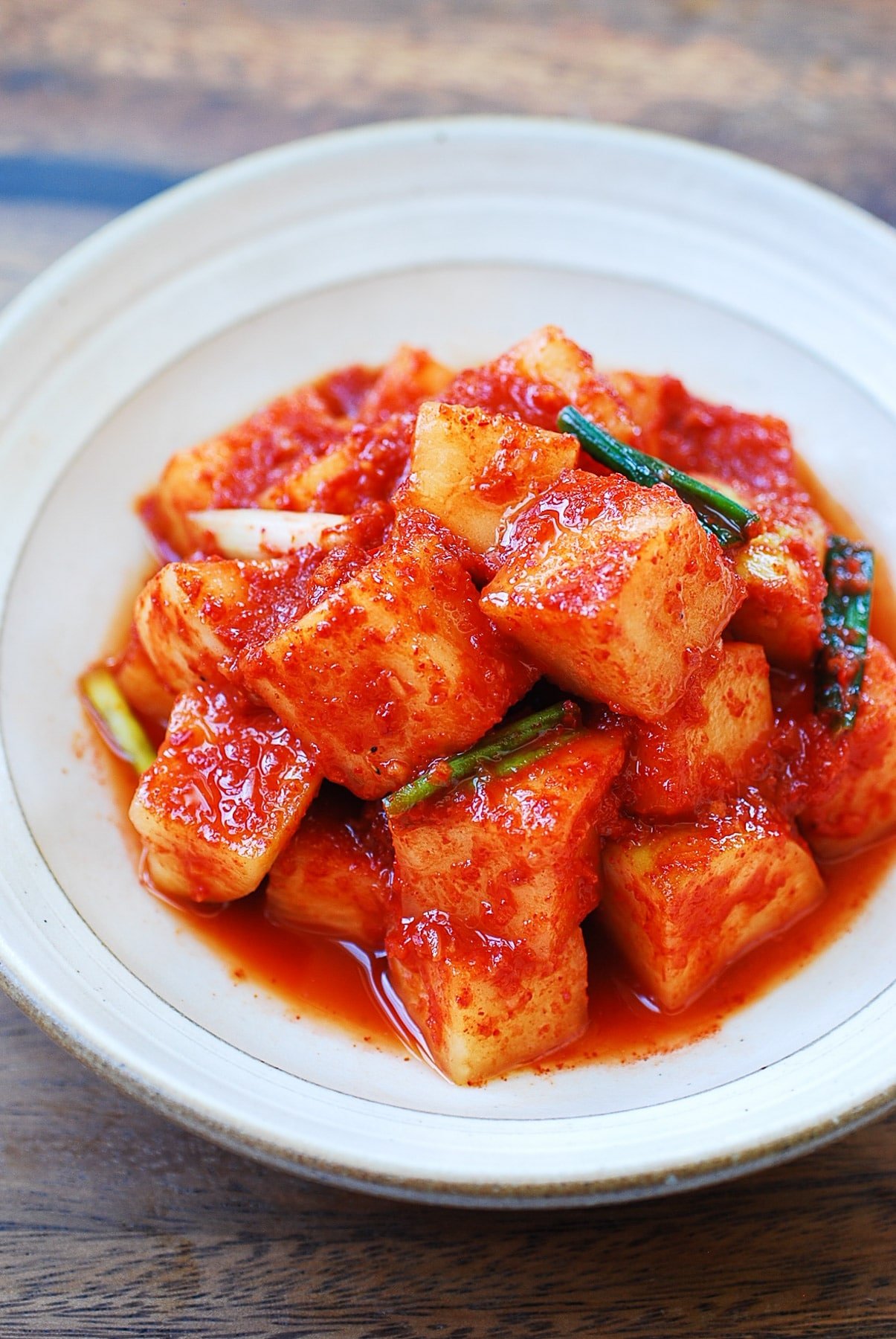
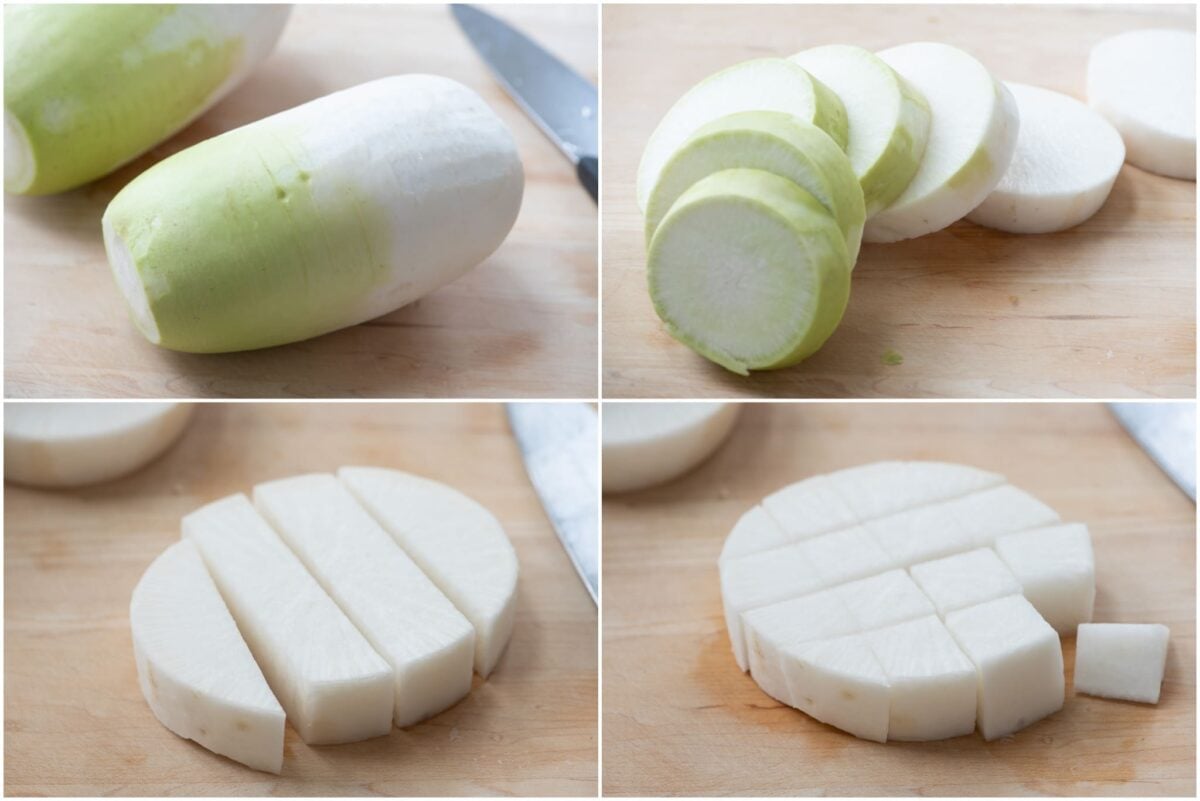
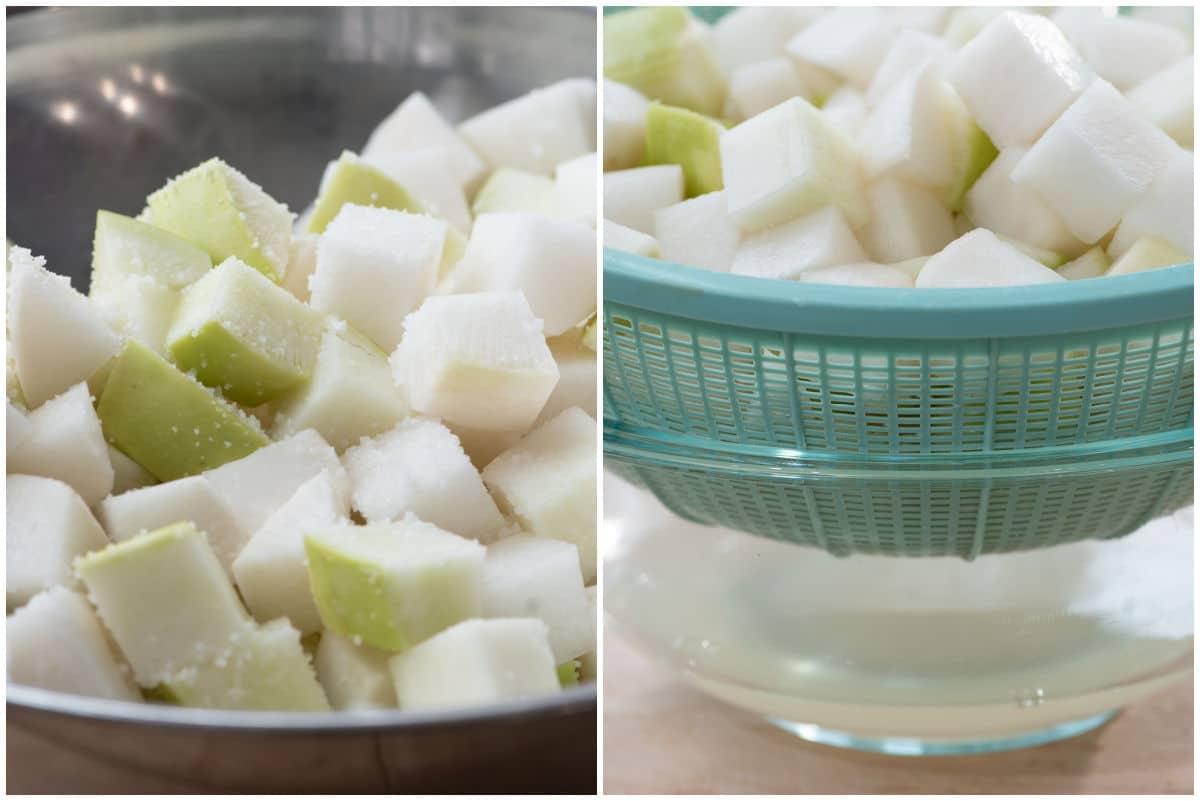
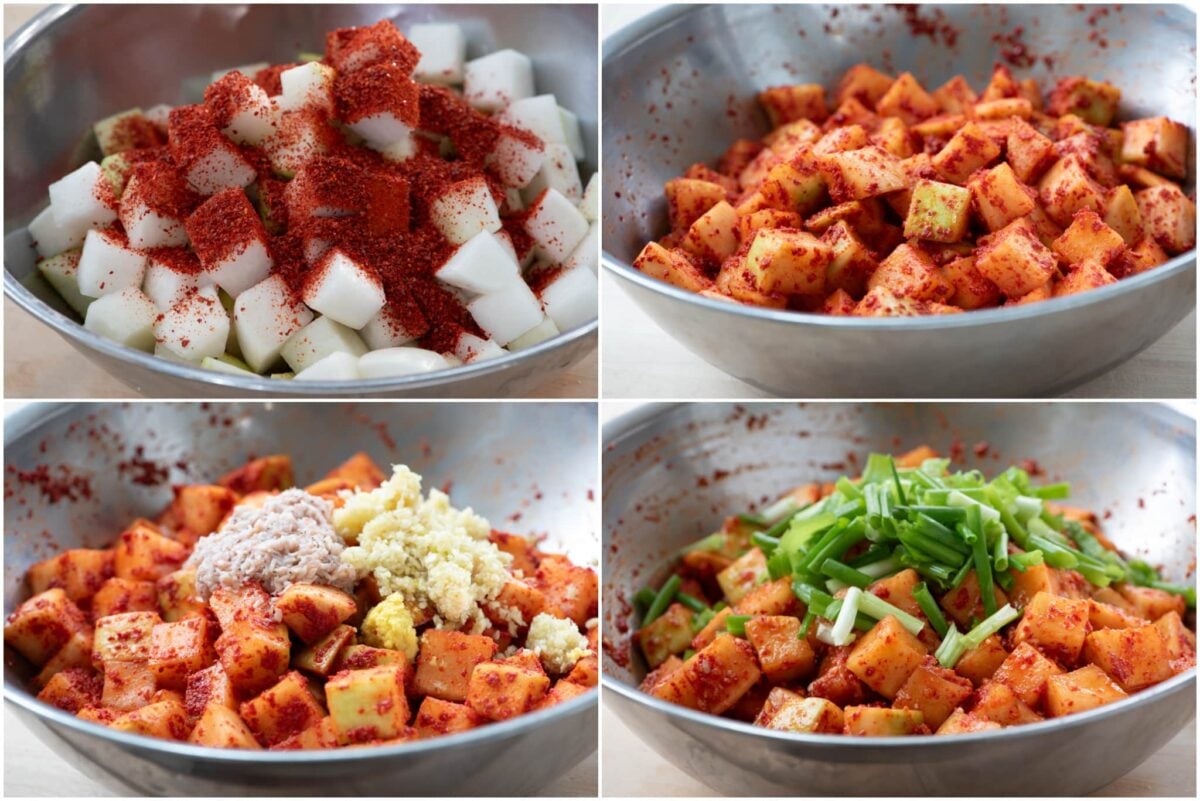
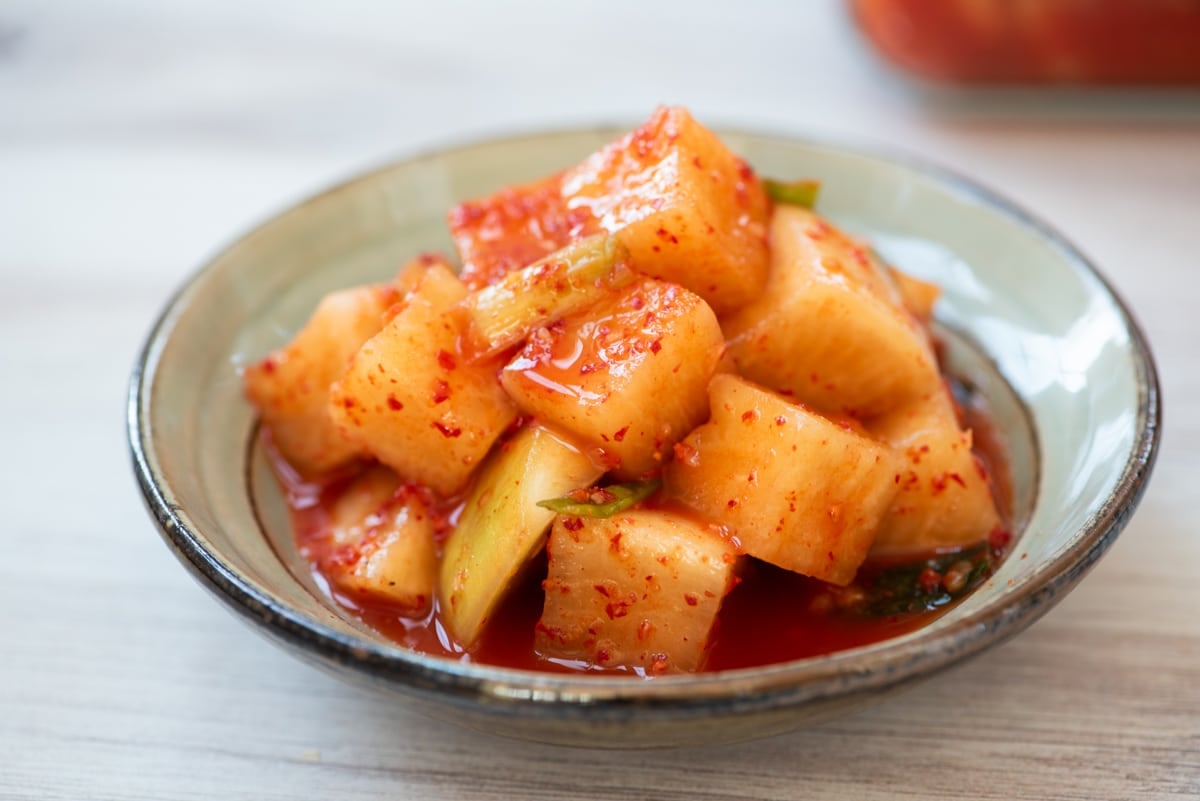





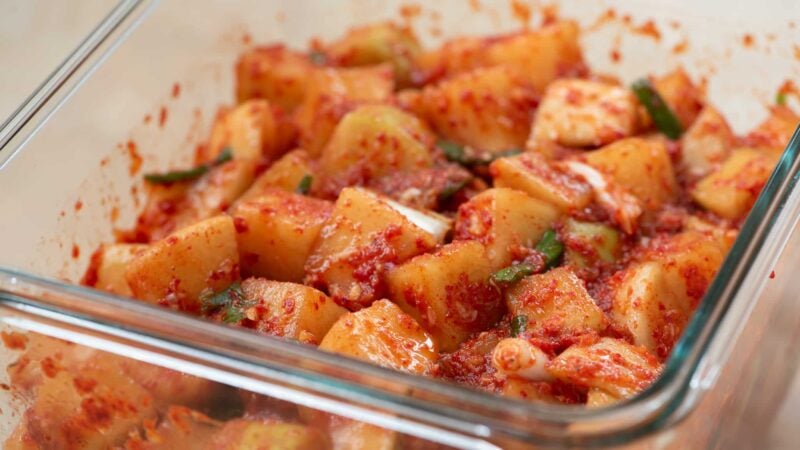
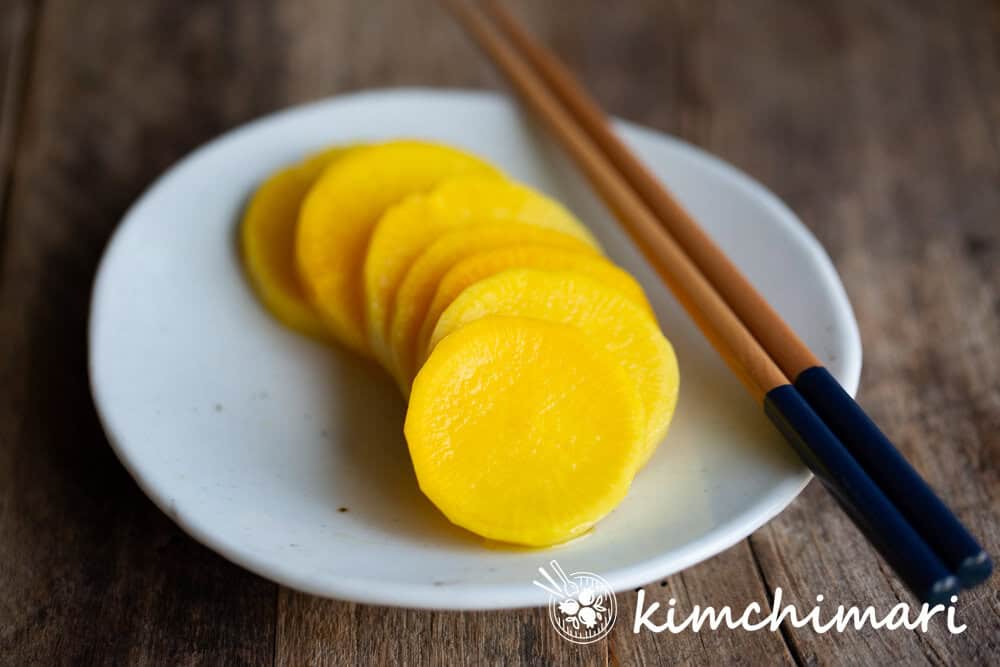









 English (US) ·
English (US) ·